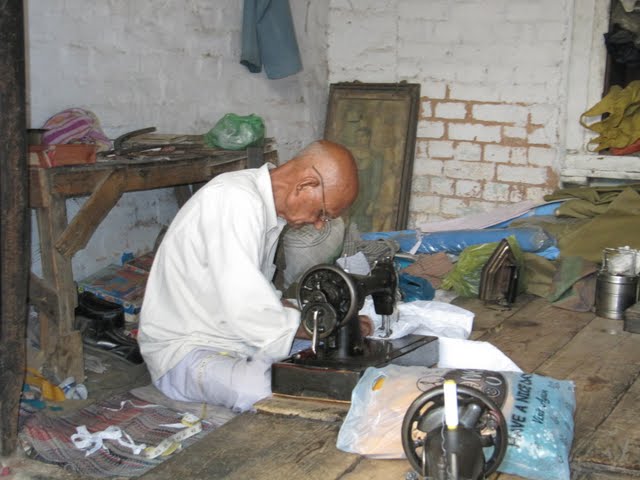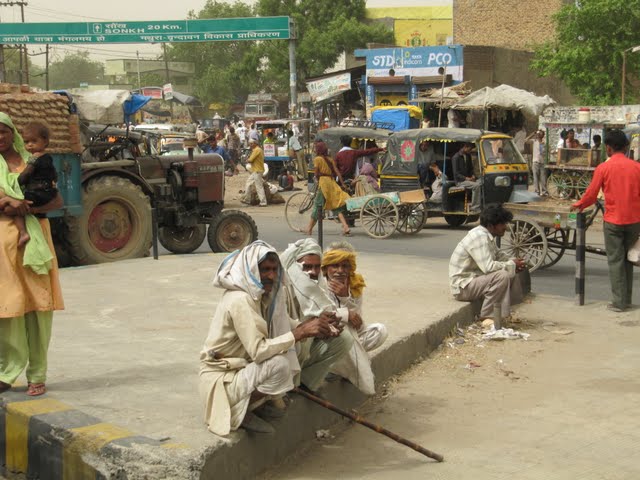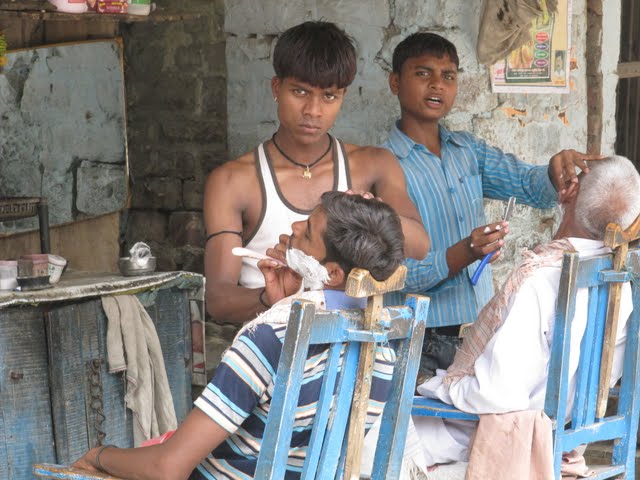Olga's impressions of traveling India, in English
A couple of thousand km, a couple of months, a couple of thousand euro and a lot of unforgettable experiences behind, we are leaving India. When asked by some local journalist that happened to be sitting next to us at the Bodhi tree what we think about India, I felt at a loss for words: most of the usual adjectives like ‘nice’, ‘great’, ‘interesting’ would be hypocritical. India was a bit of everything – at times wonderful, at times overwhelming.
The overwhelming India
On the ‘overwhelming’ side of the range there was definitely the unimaginable dirtiness of it. Here in India dirt, rubbish, spit, pee, shit and every other single ‘exhaust’ of human activity are omnipresent (see Jordi's catalan post for 'visual proof'). In the end experiencing India with all this rubbish and dirt was a bit like viewing a beautiful scenery through an extremely dirty train window – you have to mentally ‘see through’ the dirt.
Another frustrating thing of this journey was the never-ending hassling by the people in the streets. It would start the moment you arrive in any new place, with rickshaw drivers and various hotel agents bombarding you with their offers. In touristy places you would almost never get a direct answer to a simple question like ‘how do I get to place X’ – instead they would tell you a million of reasons why you should go to place Y, using their services.
Then there was this long list of ingenious things they would do try to do to get their commission: almost everybody in the street would be asking you from dawn till dusk where you are going and try to suggest a better route for you (via a place where they could get commission for bringing you there). Rickshaw drivers would try to lure us into various crafts shops, agents - convince us to go to a different hotel, taxi drivers - follow us to the hotel of our choice simply because they might as well pretend they convinced us to go there etc etc.
Part of this whole ordeal was trying to find out the fair price as the one the Indian people tell you is always something like: Foreigner Price = (Local Price * Foreigner Dummy Factor)2, where Local Price is a couple of rupees that the locals pay and the Foreigner Dummy Factor is somewhere in the range of 3 - ∞ and is based totally on their assessment of you which they complete the second they see you.
Another very colorful breed in the Indian business anthropology was the taxi / rickshaw drivers. They would agreeably nod when discussing the destination and price with you but be prepared for surprises regarding both. As to destination, they will sometimes take you to a hotel which pays them commission trying to pass it to you as the one that you asked for (the fact that some hotels and most Indian streets don’t have the name board helps them enormously). As to the price, they have a whole arsenal of tricks like having no change, charging you Foreigner Price (see the formula above), asking for more than agreed because they brought you a couple of meters further, because it is getting dark or because it was an exceptionally hot day etc.
Another thing you need to get used to in India is all the attention you get for being a foreigner, which is about the same amount of attention ET would get walking the streets in Europe. At the stations they would surround us with big crowds carefully listening to our talk and watching our every movement (for a novice it might be difficult not to choke on food/drinks under this never-ending scrutiny, but with some practice you stop noticing it).
Professional beggars in the street is another Indian species you constantly have to deal with – but as opposed to beggars in other countries who try to elicit sympathy, the Indian ones use the strategy to try to annoy you into giving some money: they will touch you, hang on your sleeves, follow you. Taking into account the huge amount of beggars, filtering between those in genuine need of help and those abusing generosity can be very difficult.
All this said, once you learn the rules of this ‘India’ game, it’s all pretty easy and you start enjoying it, just like any game. In the end of the day, as far as practical matters are concerned (sleeping, eating and logistics) backpacking through India is extremely easy – guesthouses are easily available and off season you can get great deals, street food is 24/7, train reservation system is very straightforward, and there is an extensive bus network.
Food
As to the food, we really liked it in the beginning but after some time we started to really feel the lack of variety: in the streets it would be mostly samosas (potato stuffed fried flour balls), or the thali dishes – rice with vegetable curry. Add to the above Indian freshly made yogurt (lassi) and the menu is almost complete.
In some regions there were some local specialties (like dosas - thin crunchy rice pancakes with some vegetable filling), but apart from those all the other dishes on various menus – no matter what name and ingredients - seemed to taste pretty much the same. On the bright side - fresh fruit and vegetables are easily available (mangoes are delicious).
Logistics
As far as logistics is concerned, we had a steep learning curve in the first week but after that arranging transport to our next destination was really easy. As the guide was missing some essential information on this point, in the beginning we tried to get some objective tips from tourist information offices – and ended up in private agencies which tried to sell us overpriced transportation arrangements under the source that we wouldn’t manage on our own.
The second step was to try to get more information at the governmental Foreigner Ticket Office at New Delhi station – that’s where we got ourselves into yet another scam cobweb and ended up in yet another private agency. Then we finally got to this office where one of the many idle and indifferent employees did give us a couple of tips. After that we resolved to ourselves that we would reserve all the tickets on our own and after a couple of days of struggling with the extremely slow www.irctc.co.in interface over even slower Internet and with absolute lack of information about all the specifics of this system, we did manage to book all out tickets.
Train tickets - IRCTC
And here is the summary of what we learnt about Indian railway: using their online system you can book 10 tickets per month per username (we created a second user once we exhausted the 10 transactions). Booking is advisable as much in advance as possible as the seats and berths are gone very fast – even for the tickets we were booking 2 months in advance the availability was surprisingly low (just a few berths). Important terms to learn in the IRCTC vocabulary concern the classes of the coach ( = your comfort) and the availability of the tickets (available versus waiting list).
Classes: for short connections AC Chair is a perfect option – cool coach, soft seats. For overnight connections there are Sleeper, 3AC, 2AC and 1AC versions (from cheapest up). As we learnt, 3AC was fine value for money. Sleeper could be crowded and noisy, and more expensive 2AC/1AC are the same but with fewer berths per department, which hardly matters when you sleep.
Availability: WL – waiting list, RAC – reserved against cancellation, and the lucky Av – available. When checking availability for a specific train, specific class (our default option was 3AC), if you see: Av 10 - consider yourself lucky and book your tickets, RAC 2 - consider yourself a little less lucky as it’s not as great as a fully available berth/seat but it does get you on the train (as somehow they make a seat or berth for you). WL 20 / WL 18 – the least lucky option as it means that there are no seats/berths available and the current queue has already peaked at 20 but went down to 18 as two people cancelled their reservation.
This is a very essential peculiarity of the Indian reservation system – people do cancel quite often, as it’s very easy and costs almost nothing, so people book for various dates and then cancel the ones they no longer need, or book different classes and then cancel the expensive ones as the cheaper ones get canceled by someone else and so on and so forth. So actually, when you see WL 20 / WL 18 for the 3AC class you are checking, what you can do is book it anyway in the hope 18 more people will cancel and you will get your berth (if this miracle happens the berth is yours automatically and you will get a confirmation). But you should first check the more expensive 2AC – if there are berths available in this class, it’s easier to pay more for a guaranteed sleeping place and be done with this specific booking. But it’s also possible (we heard Indians do it regularly and we also did it) is to book both wait-listed 3AC and available 2AC, and then cancel 2AC if 3AC becomes available (it will be much cheaper despite the cancellation fee), or 3AC if it never becomes available (there is no cancellation fee for a wait-listed reservation).
Important things to know about Indian trains: they are almost always late (easily by a few hours either on departure, or arrival, or both) and almost always change their platform in the last minute, so you need to keep asking and stay very alert and ready to react (because of such a change of the platform which we were totally unprepared for, we had to catch our first train running – exactly like in the Darjeeling Limited movie). Otherwise the trains are comfortable and saved us a lot of time due to comfortable overnight timing.
We booked all our trains within the first 2 weeks, as soon as we decided on our itinerary, and it proved to be a great help, as except for a couple of exceptions where we found a bus with a better schedule, we did need all those trains, and in some cases buses would have been not possible and absence of advance train reservation would mean we would have had to go unreserved ( = painful). For short connections, up in the mountains or for some specific overnight connections we used buses.
Buses
In India it’s possible to travel almost anywhere by bus. Buses are less comfortable than trains but cheaper and for overnight connections they have sleepers. It’s usually no problem to get a seat for the next day so it’s a great alternative to trains but you don’t know hundred percent whether there is a bus to your next destination (as in some specific places only trains are possible). So trains vs buses is a personal choice. In our case it was great to have most of the train reservations but in some cases not having them would have been just as fine as a bus was easily available.
"The culture shock"
The cultural aspect of contemporary India that struck us was the surviving century-old traditions. The people in this country still live incredibly close to nature, probably partially due to lack or absence of technology to substitute human labour (we heard that the government deliberately keeps all this labour manual since there are so many people who depend on these jobs, which if true is a dead-end strategy in the long run). They also all belong to one of the common religions – Sikh, Hindi, or Muslim, and practice it very actively by going to temples/mosques and saying daily prayers.
What struck us however is that the belief seems to be rather ritual oriented, as the people we were seeing in the streets wouldn’t care much to which god they would be offering a prayer: passing by a Buddhist temple they would do the bows and prayers like in any other temple. As to traditions, it’s amazing but almost all women apart from a few highly emancipated ones we saw in big cities wear Saree's, paint their feet in bright colors, wear tingling bangles and anklets, and decorate their hands and feet with henna tattoos.
They ‘make up’ their small kids with black eye-liner to protect them from evil. They also cram themselves in unimaginable numbers into rickshaws and buses, apparently having much smaller ‘individual space’ margins than Europeans. Some things they do are more ecology-friendly than those we do in Europe – they use plates made of leaves instead of plastic in their street ‘fast-food’ stalls and clay pots instead of plastic cups in the lassi places (funnily enough you are supposed to break it once you are done - it’s so cheap for them to buy a stock of those that they don’t wash the used ones).
They also have a lot of small kids collecting plastic bottles - the government really promotes recycling at the same time giving a source of income to those who would otherwise probably beg. But they have zero rubbish bins – whether you want it or not you will develop a habit of throwing things on the ground while in India. In some places you can still see extreme poverty with people living in slums (sometimes a ‘home’ is just a plastic cover from rain and the whole household is a size of my backpack). Some kids don’t go to school – they work or beg instead.
In the villages, observing the caste system, marrying whoever your parents chose, the bride’s dowry being her most valuable asset and the like things are still a very essential basis of daily life, whereas in big cities it’s a definite past.
The incredible India
On a closing note, we did thoroughly enjoy our trip through India – we saw a lot of incredible places, with the main highlights being Himalayas (Kashmir and Ladakh), Golden Temple in Amritsar, Jaisalmer camel safari, Ajanta caves, cozy Varanasi and civilized Mumbai. In some aspects it was like time-travel, with so many things striking us as being centuries old.
What I do wonder is whether if some time in the future we were to come to India again, whether it would be even more "backwards"... For the sake of all the hard-working and kind people we met I would hope I'm wrong...







